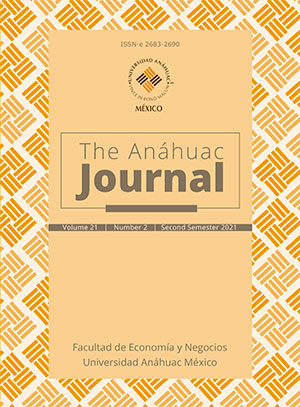El mercado mundial de aguacate: 60 años del liderazgo de México y su impacto en la próxima década
Contenido principal del artículo
Resumen
En esta investigación se estudia el liderazgo de México durante 60 años (1961-2019) en la producción y comercialización mundial de aguacate. El análisis de correlación de Pearson de las variables que integran el mercado —oferta (producción), demanda (consumo) y precio— comprueba que la correlación de las variables es «alta» y «directa», sin embargo, no es «perfecta», con lo que se demuestra que en el mediano o largo plazo la rentabilidad del negocio se verá afectada. Esto es así debido a que no existe una dinámica proporcional entre las tres variables (la tendencia del incremento en el volumen de producción/oferta es mayor que la demanda). Se comprueba que la oferta es la que determina que suba o baje el precio del producto (Smith, 1776, s/f) y que, al no haber una estrategia comercial coordinada del sector aguacatero de México, los ingresos del productor nacional se reducirán sistemáticamente hasta que el mercado encuentre su punto de equilibrio.
Downloads
Detalles del artículo
Sección

Esta obra está bajo una licencia internacional Creative Commons Atribución-NoComercial-CompartirIgual 4.0.
The Anáhuac Journal se distribuye bajo Licencia Creative Commons Atribución-NoComercial-CompartirIgual 4.0 Internacional.
Cómo citar
Referencias
Asociación de Productores y Empacadores de Aguacate de Michoacán (APEAM). (2 de diciembre de 2020). «Producción de aguacate en México». http://www.apeamac.com
Bosch García, C. (2003). La técnica de la investigación documental. (12.a ed.). Editorial Trillas. 143 pp.
Cohen, J. (1988). Statistical power analysis for the behavioral sciences. (2.a ed.). New York University.
Consejo Nacional de Productores de Aguacate (Conapa) y Comité Nacional del Sistema Producto AGUACATE, A.C. (Conasipro). (22 de septiembre de 2020). «Productores de aguacate». Modula Revista. http://www.productoresdeaguacate.com/MODULArevista/modulos/web/www/index.php
Cruz, P.C. (7 de febrero de 2018). «Producción e intercambio comercial del aguacate mexicano». El Economista. https://www.eleconomista.com.mx/opinion/Produccione-intercambio-comercial-del-aguacate-mexicano-I-20180207-0137.html
Escamilla, G. (1996). Manual de metodología y técnicas bibliográficas. (3.ª ed.). UNAM.
«Estados Unidos levanta la veda a frutas y vegetales de República Dominicana». (17 de diciembre de 2017). Agencia EFE. https://www.efe.com/efe/america/economia/estados-unidos-levanta-la-veda-a-frutas-y-vegetales-de-republica-dominicana/20000011-3469808
Estrada, C. (15 de febrero del 2020). «El apetito voraz de aguacates». La Jornada del campo.
https://www.jornada.com.mx/2020/02/15/delcampo/articulos/apetito-voraz.html
Guevara, W., Hidalgo-Alcázar, C. y Rojas, J. L. (2021). «Análisis de la agroindustria chilena del aguacate (palta) en el mercado internacional». Chilean Journal of Agricultural & Animal Sciences, 37 (1), 54-64. https://revistas.udec.cl/index.php/chjaas/article/view/3768
Johnson, B. y Onwuegbuzie, A. (2004). «Mixed Methods Research: A Research Paradigm
Whose Time Has Come». Educational Researcher. 2004, 33 (7), 14-26. https://doi.org/10.3102/0013189X033007014
Ley del Mercado de Valores. (2020). https://www.pld.hacienda.gob.mx/work/models/
uif/librerias/documentos/mj /Ley_del_Mercado_de_Valores.pdf
Martínez, M. del P. (31 de enero de 2018). «Productor principal de aguacate en México».
El Economista. https://www.eleconomista.com.mx/empresas/Mexico-principalproductor-de-aguacate-20180131-0111.html
Minitab. (s/f). Herramientas estadísticas, de análisis de datos y de mejora de procesos.
Recuperado el 4 de octubre de 2020 de https://www.minitab.com/es-mx/
Organización de las Naciones Unidas para la Alimentación y la Agricultura (FAO). (2020).
Producción mundial de aguacate (base de datos). http://www.fao.org/faostat/es
Pardinas, F. (1999). Metodología y técnicas de investigación en ciencias sociales. Siglo XXI Editores.
Pérez Porto, Julián y Ana Gardey (2017). Definición de correlación, https://definicion.de/correlacion
Sistema de Información Agroalimentaria y Pesquera (SIAP). (2020). Información Estadística
Agropecuaria de México (base de datos). https://www.gob.mx/siap
Smith, A. (1776, s/f). La riqueza de las naciones (trad. C.R. Braun). Secretaría de Educación Coahuila. http://web.seducoahuila.gob.mx/biblioweb/upload/1 %20La %20riqueza %20de %20las %20Adam %20Smith.pdf
Wayne, W. D. (1990). Estadística con aplicaciones a las ciencias sociales y a la educación. McGraw Hill.

